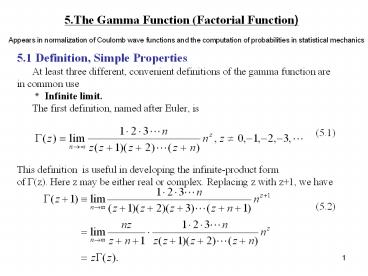5.The Gamma Function (Factorial Function) PowerPoint PPT Presentation
1 / 16
Title: 5.The Gamma Function (Factorial Function)
1
5.The Gamma Function (Factorial Function)
Appears in normalization of Coulomb wave
functions and the computation of probabilities in
statistical mechanics
- 5.1 Definition, Simple Properties
- At least three different, convenient
definitions of the gamma function are - in common use
- Infinite limit.
- The first definition, named after Euler, is
-
(5.1) -
- This definition is useful in developing the
infinite-product form - of G(z). Here z may be either real or complex.
Replacing z with z1, we have -
(5.2)
2
This is the basic functional relation for G (z)
. Also from the definition
(5.3)
(5.4)
Definite integral (Euler)
A second definition, also frequently called
Eulers form, is
(5.5)
3
The restriction on z is necessary to avoid
divergence of the integral. When G (z) does
appear in physical problems, it is often in this
form or some variation such as
(5.6)
(5.7)
When z1/2, Eq.(5.6) is just Gauss error
function, and we have the interesting result
(5.8)
To show the equivalence of these two definitions,
consider the function of two variables
(5.9)
with n is a positive integer. Since
(5.11)
4
by Eq.(5.)
Returning to F(z, n) , we evaluate it in
successive integration by parts. For convenience
let u t/n . Then
(5.12)
Integrating by parts, we obtain
(5.13)
Repeating this, we finally get
(5.14)
5
This is identical with the expression on the
right side of Eq.(5.1). Hence
(5.15)
by Eq.(5.1), completing the proof
Infinite product
The third definition is
(5.16)
where ? is the Euler-Mascheroni constant,
(5.17)
This form can be derived from the original
definition by writing it a
6
(5.18)
Inverting and using
(5.19)
we obtain
(5.20)
Multiplying and dividing by
(5.21)
we get
7
(5.22)
Factorial notation
Eq.(5.5) can be rewritten as
(5.25)
to define a factorial function z! The factorial
function of Eq.(5.5) is, of course, related to
the gamma function by
8
(5.27)
If z n, a positive integer, we have
(5.28)
However, it should be noted carefully that z! is
now defined by (5.25) the factorial function is
no longer limited to positive integer values of
the argument (Fig.5.1). The difference relation
(Eq.(5.2)) becomes
(5.29)
9
This shows immediately that
0!1 (5.30)
for n, a negative integer.
Double factorial notation
In many problems, we encounter products of the
odd (or even) positive integers. For
convenience these are given special labels as
double factorial
(5.33b)
Clearly, these are related to the regular
factorial by
(5.33c)
10
5.2 Digamma Functions
As may be noted from the three definitions
in the previous section, it is inconvenient to
deal with the derivatives of the gamma or
factorial function directly. Instead, it is
customary to take the natural logarithm of the
factorial function(Eq.(5.1)), convert the product
to a sum, and then differentiate, that is
(5.36)
(5.37)
Differentiating with respect to z, we obtain
(5.38)
11
which defines F(z), the digamma function. From
the definition of the Euler constant, the above
equation may be rewritten as
(5.39)
5.3 The Beta Function
Using the integral definition(Eq.(5.25)), we
write the product of two factorials as the
product of two integrals. To facilitate a change
in variables, we take the integrals over a finite
range.
(5.57a)
Replacing u with x 2 and v with y 2 , we
obtain
(5.57b)
12
Transforming to polar coordinates gives us
(5.58)
The definite integral, together with the factor
2, has been named the beta function
(5.59a)
Equivalently, in terms of the gamma function
(5.59b)
13
Definite integrals, alternative forms
The beta function is useful in the
evaluation of a wide variety of definite
integrals. The substitution t(cos?) 2 converts
Eq.(5.59) to
(5.60a)
Replacing t by x 2 , we obtain
(5.60b)
in Eq.(5.60a) yields still another useful form
The substitution
(5.61)
14
Verification of p a / sin p a a ! (- a
)! relation
If we take m a , n -a , 0lt a lt 1, then
(5.62)
On the other hand,
the last equality is obtained by using the
previous result for the contour integral in
Chapter 2).
Therefore, we have proven the relation.
15
5.4 Incomplete Gamma functions
Generalizing the integral definition of the gamma
function, we define the incomplete gamma
functions by the variable limit integrals
and
(5.68)
Clearly, two functions are related, for
(5.69)
The choice of employing or
is purely a matter of convenience. If the
parameter a is a positive integer, Eq. (5.68)
may be integrated completely to yield
16
(5.70)
Error integrals
(5.8a)
They can be written as incomplete gamma functions
a 1/2 . The relations are
(5.8b)

